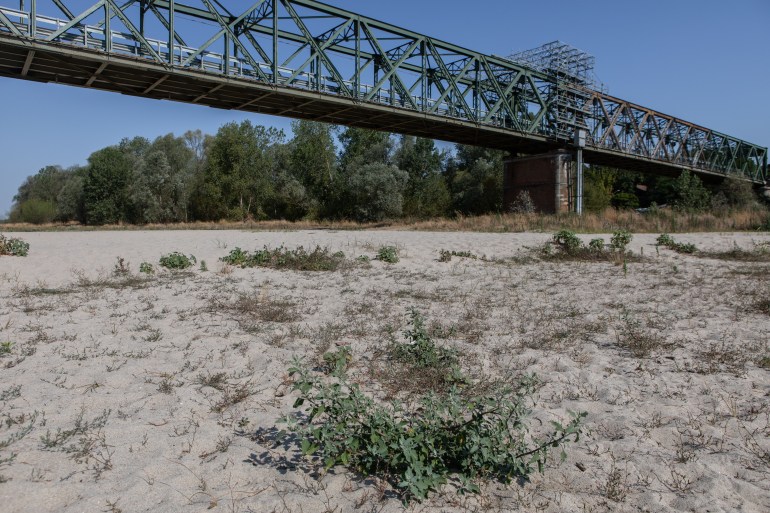The drying up of a river in the US state of Texas revealed footprints that were previously hidden by the water, belonging to dinosaurs that probably lived about 113 million years ago.
This discovery is added to a group of antiquities that have been unveiled thanks to the drought that hits large areas of the earth, after it remained unknown for many centuries.
It appears that the deep ruins were previously underwater and filled with sediments that contributed to their preservation, but "severe drought conditions this summer have drained most of the Paloxi River, revealing new traces," according to Texas Parks and Wildlife Department official Stephanie Salinas Garcia.
This discovery brought happiness to the hearts of workers at Dinosaur Valley State Park near Dallas, which was given this name due to the presence of a large number of traces of dinosaurs in it.
Low water levels and drought reveal giant footprints of dinosaurs dating back over a million years in Texas, USA pic.twitter.com/Q4F87mx0Uw
- Al Jazeera (@AJArabic) August 25, 2022
The new discovery may be one of the longest chains of dinosaur footprints in the world, according to the park administration, which was opened in 1972 to protect ancient monuments, and which published pictures in which volunteers were working to clean the footprints to appear more clearly.
Garcia said that "most of the effects that were recently discovered in different locations of the river in the park belong to a dinosaur of the type Acrocanthosaurus", which is one of the best-legged and could have reached 5 meters in length and weighed 7 tons, while another group belonged to dinosaurs of the type "Sauroposidon" that were With its long neck, it can reach up to 18 meters in length and weigh up to 44 tons when it reaches maturity.
She pointed out that "the history of dinosaur traces in the park goes back 113 million years," calling on those interested to hurry up to see the new monuments before the rains fall and flood them again.
Effects and warnings
Low rainfall and high temperatures for long periods, causing unprecedented droughts that hit many countries;
Over the past few weeks, Europe has turned into a ball of flames, with record temperatures lowering the water levels of the continent's great rivers, turning green spaces into barren lands, and even revealing a warning from our ancestors about periods of misery and misery.
“If you see me, cry”
is one of the phrases engraved centuries ago on rocks called “hunger stones” in Europe.. have you heard of it?
Recently, news sites reported the appearance of some of these stones in Europe due to the drying up of some rivers.
pic.twitter.com/XYM1WCP2XF
— AJ+ Arabic (@ajplusarabi) August 18, 2022
hunger stones
The receding waters of the Elbe River in the Decin region in the Czech Republic have revealed the so-called "hunger stones", which are rocks in riverbeds that can only be seen when water levels are very low.
Inscribed on these stones are messages left by people in previous eras about disasters caused by lack of water, a stark reminder of the difficulties they faced during previous droughts, according to the BBC.
These inscriptions date back to previous decades and centuries, as shown on the account of "Bataletas" in a topic published on the eighth of August and spread widely about two weeks ago.
The oldest inscription found in the Elbe basin dates from 1616 and is written in German.
The text written on the stone says, "If you see me, cry."
This "hunger stone" is particularly notable, as it also has dates of severe drought on its surface.
According to a study conducted by a team of Czech archaeologists in 2013, the years 1417, 1616, 1707, 1746, 1790, 1800, 1811, 1830, 1842, 1868, 1892 and 1893 can be read on the stone.
An inscription on one of the other rocks says, "Life will flourish again once this stone is gone."
Another inscription reads, "The one who saw me once cried. He who sees me now will cry."
A third says, "If you see this stone again, you will cry. That's how the water was shallow in 1417."
The Po River, Italy's longest, has dried up (Getty Images)
wreckage and explosives
The low water level in the Danube River in Serbia also revealed the sunken wrecks of World War II-era ships, still laden with explosives.
The ships found near the town of Prahovo were part of a Nazi fleet that sank in 1944, and more are expected to appear as the current drought continues.
In Italy, the drying up of rivers led to the discovery of unexploded ordnance in the Po River, including a World War II bomb that remained submerged.
Explosives experts defused the 450-kilogram bomb, after evacuating about 3,000 people from a village near Mantua last July.
In Spain, traces of very old stone burials, or what we can call "Spanish Stonehenge", appeared in the "Valdethanas" water basin in the province of "Caceres" in the center of the country.
It is believed that these circles of stones, which are officially called "the burials of Guadalbiral", dated back to 5000 BC.
It was discovered by an archaeologist in 1926, but the area was submerged in a rural development project in 1963.
It is noteworthy that the European continent is experiencing an unprecedented drought, the worst in 500 years, according to what was announced by the Joint Research Center of the European Commission.

